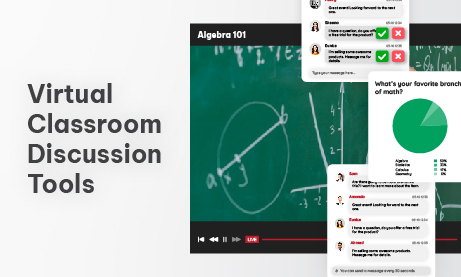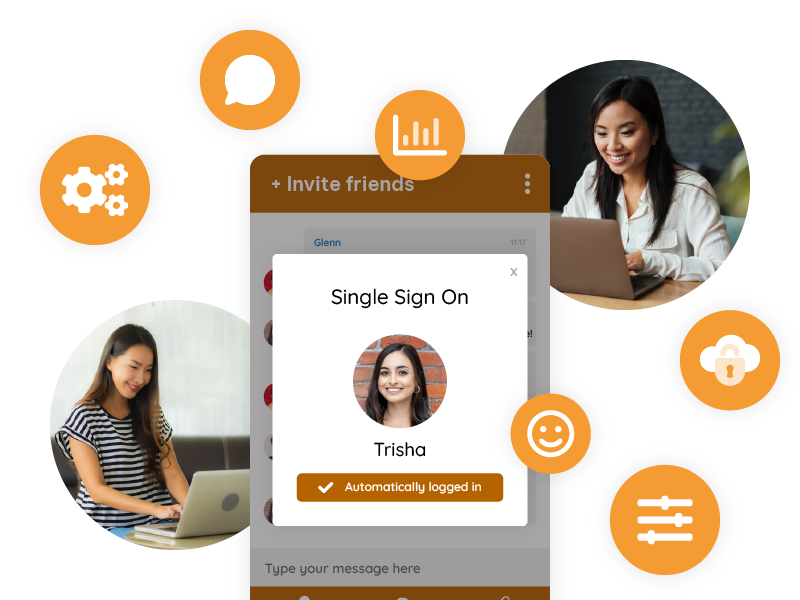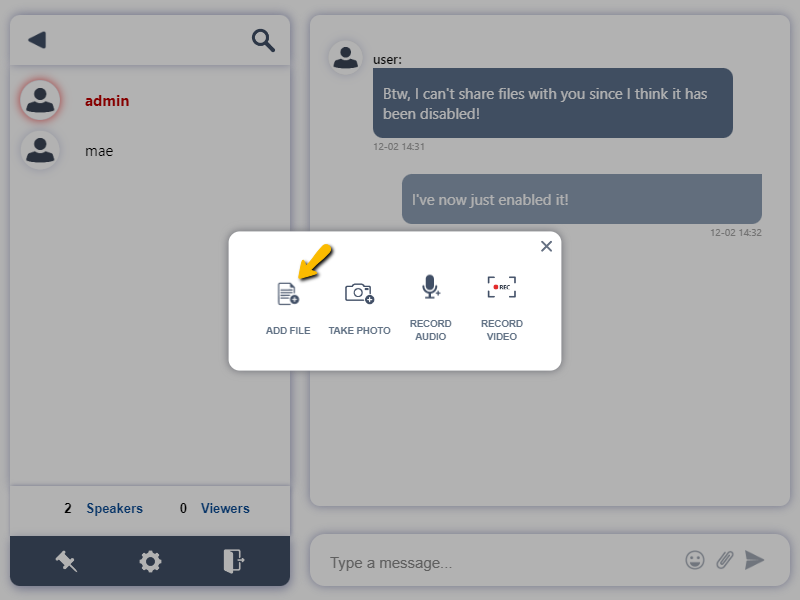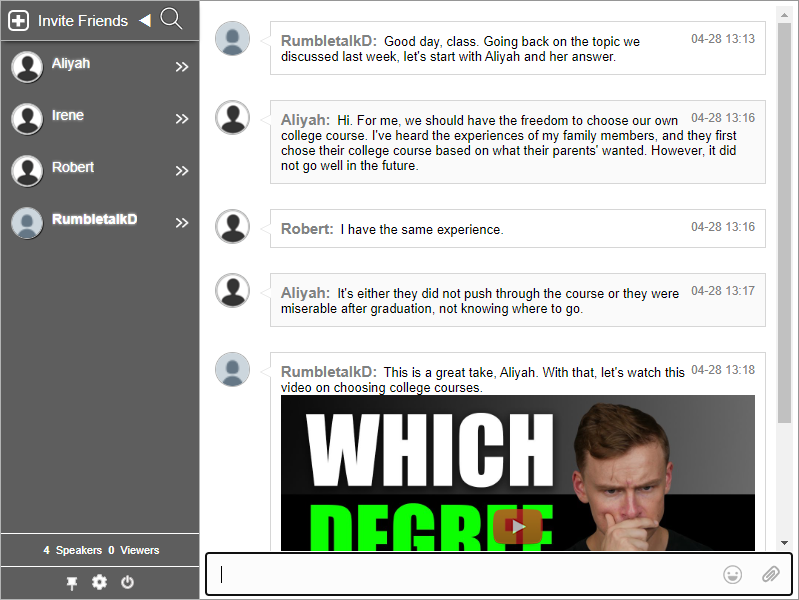The sudden, rapid expansion of online learning over the past few years has ushered in an unprecedented era of opportunity—and challenges—for learners, teachers, and administrators alike. Virtual classroom discussion tools now play a central role in distance learning, enabling the closing of the gap between teacher and student in cyberspace. They come in the form of chat systems within a Learning Management System (LMS) or course website that support synchronous (real-time) or asynchronous text discussions.
Yet, not all chat solutions are created equal. A moderated chat solution can significantly enhance the quality of online education by ensuring structure, safety, and inclusivity. In this article, we’ll examine the evolving landscape of virtual classroom technology, discuss why moderated chat is especially vital in online learning contexts, and suggest best practices and features to look for when implementing a discussion tool for your virtual classroom.
1. The Onset of Virtual Classroom Discussion Tools
From “Emergency Remote Teaching” to Permanent Adoption
When the COVID-19 pandemic hit, thousands of schools all over the world turned to online platforms for “emergency remote teaching.” The overnight solution became a full-fledged aspect of learning and has since been a part of the curriculum in many schools, colleges, and training schools. Hence, online discussion forums, real-time chat sessions, and video conferencing tools are an inextricable part of education today.
The Core Challenge: Fostering Participation and Engagement
One of the greatest challenges in an online classroom is establishing real, meaningful interaction. In a traditional classroom, the instructor can see students’ faces, read body language, and read between the lines to gauge understanding and interest. Online, though, these subtle cues are not visible. Students can feel more isolated and less at ease with expressing themselves—especially if the class is large or they are afraid of “revealing ignorance” to others.
A well-designed chat solution allows students to post questions, respond to prompts, or chat with classmates in real-time in an informal manner without the intimidation factor of responding on camera or mic. Chat has a lower barrier to participation by nature. And by adding moderation features to the mix, you have a designed space where instructors can dampen the noise, manage the conversation, and get everyone’s voice heard—much more learner-friendly.
2. Why Moderated Chat Solutions Excel in Virtual Classrooms
2.1 Ensuring Safe, Respectful Discussion
With any group discussion, there’s always the risk of off-topic posts, harassment, or unwanted material. Moderated chat solutions help teachers or designated helpers screen messages before they appear to the class. This can be done in a number of ways:
• Pre-approval of questions: Students submit their questions or comments, which are not displayed until a moderator rejects or approves them.
•Keyword filtering: Some potentially offensive or dangerous keywords can be automatically flagged for moderator review.
•Role-based permissions: Teachers, teaching assistants, and administrators can have varying levels of control, allowing them to moderate discussions without dampening the overall flow.
By keeping the atmosphere positive, learners feel supported and safe—two ingredients that make a big difference in meaningful engagement.
2.2 Avoiding “Chat Overload”
During an unmoderated chat, students can easily get overwhelmed by the rapid pace of messages, emojis, GIFs, and diversions. Chat overload will make a learning tool a distraction. A moderation system ensures order:
- Threaded or topic-based discussions: Administrators may create rooms or topics per lesson, so the conversation stays on track.
- Time-released discussions: Some chat platforms allow moderators to time-release messages or questions, keeping wild back-and-forth in check.
- Pinned posts or top news: Critical messages, deadlines, or materials may be pinned or showcased at the top of the conversation so that they don’t fall through the cracks.
2.3 Engaging Participation and Depth
Ironically, a moderate level of control can actually enrich participation. Those who would fear public condemnation can contribute in writing, with a teacher reading and moderating them first. This guarantees more reflective contributions and safeguards against risks of off-task conversation or derision by peers, risks that may stifle contribution in less formal environments.
2.4 Incorporation with Other Learning Tools
One significant advantage of moderated chat solutions is the way they can be integrated into virtual learning tools that the institution already employs. As an example, chat widgets may be integrated into a school’s Learning Management System (LMS) such as Moodle, Blackboard, or Canvas. They can also be integrated into live video streams (e.g., Zoom, Microsoft Teams, or a proprietary streaming platform) so that students can watch a lecture or presentation and simultaneously have a side discussion. This seamless integration makes user experience easier, enabling students to focus more on the content and less on toggling between multiple tools.
3. Creating Virtual Classroom Discussion Tools for Success
3.1 Accessibility and User Experience
In order to succeed, a chat solution must be usable and accessible. Consider the diverse group of students: some will be on tablets, smartphones, or lower-speed laptops. Others will have disabilities that require screen readers or alternative input modes. Key accessibility and UX capabilities are:
- Responsive design for any screen width
- Keyboard navigation and support for screen readers
- Visual hierarchy (e.g., color contrast, chat bubbles, timestamps)
- Multi-language support, if necessary, for multilingual classrooms
When students can easily engage in chat functionality regardless of device or capabilities, naturally, engagement increases.
3.2 Moderation Modes and Customization
Educators have varying degrees of comfort with how much they must control the classroom chat. Therefore, the ideal chat solution must permit educators to turn moderation up or down. Standard moderation modes include:
- No moderation: Messages appear immediately without approval (suited for small, trusted communities or casual brainstorming sessions).
- Full moderation: Messages only show up after approval by teacher or assistant (ideal for big or open-enrollment classes, or when discussing sensitive topics).
- Keyword-based filtering: Automatic screening for profanity or spam, marked for moderator attention.
- Selective moderation: Teachers or assistants can rapidly “mute” or “ban” problematic users, while letting the rest of the chat proceed normally.
Apart from modes, the ability to brand and personalize the chat window with school colors, logos, or even class themes can create a feeling of belonging and community.
3.3 More Advanced Features for More Engaging Interaction
To truly make a chat window an actual learning environment, think outside text exchange:
- Threading: Have students reply to a specific comment or question in a sub-thread, keeping it organized.
- Polling: Incorporate live polls or quick quizzes to check for understanding or obtain opinions.
- Q&A module: Segment questions from spontaneous comments so teachers can answer questions in a more controlled way.
- File Sharing: Allow for sharing of photos, PDFs, or short videos (there are moderation controls in place to prevent objectionable files).
- Analytics: See what messages get most responses or how many active students, to assist in planning future lessons.
4. Best Practices for Moderated Chat in Virtual Classrooms
4.1 Define Clear Guidelines
Prior to jumping into online discussion, define rules of engagement clearly. For example:
“This chat is for course-related questions and respectful peer discussions. Please stay on-topic. Any off-topic, disrespectful, or spam posts will be deleted.”
By defining guidelines clearly—perhaps even as a pinned post—you establish expectations for student behavior. Students like to know what is expected, and this helps create a respectful environment from the beginning.
4.2 Find a Balance Between Control and Openness
Moderation is essential, but over-moderation can stifle creativity and spontaneity. If students know that every comment is being filtered, they may not volunteer ideas or ask questions. So, find a balance that maintains control but leaves room for open-ended discussion. Some teachers start off with controlled Q&A, followed by opening up the discussion after trust has been established.
4.3 Use Moderators or Teaching Assistants
One or more teaching assistants (TAs) or student volunteers may sometimes be useful as moderators. It relieves instructors from the pressure of tracking down every single comment while teaching. TAs can identify main questions, maintain guidelines, and perform behind-the-scenes tasks so that the teacher can remain focused on delivering top-notch instruction.
4.4 Use Pre- and Post-Class Discussion
Moderated chat is not reserved for live instruction. You can have the chat room open before and after scheduled classes for socializing, “office hours,” or student collaboration. By extending moderated posting beyond off-class times, students have a safe, accessible forum for homework help, group assignment brainstorming, or sharing information. This encourages continuity of learning and feelings of membership outside the formal lesson.
4.5 Monitor Engagement Metrics
Most of the chat tools available today are pre-integrated with analytics dashboards. Think in terms of metrics such as:
- Active Participation: The number of distinct students that are active in each session.
- Message Volume: The quantity of messages (questions, answers, comments) that are posted per session or per user.
- Session Duration: How long the students remain active in the chat.
- Response Rates: How quickly TAs or instructors respond to student questions.
These are things you can learn from. If you notice low engagement, experiment with icebreaker questions or specify times when students must engage (e.g., a “response window” for class credit). If the discussion becomes unruly, you may need more strict moderation modes or more TA.
5. Benefits of a Well-Working Moderated Chat for Learning
5.1 Greater Inclusivity
Perhaps the most tangible benefit is accessibility. There are some students who cannot express themselves in a real-time video setting due to nervousness, language, or background noise. Text chat provides a gateway for them to express themselves on their own time, often resulting in more thoughtful and considered posts. A moderated forum also enables softer voices not to get drowned by noisier classmates.
5.2 Deeper Understanding and More Substantive Discussions
If students write long answers in a moderated chat room, debate quality might be better than in unmoderated or purely spontaneous rooms. Students can take their time to write answers, cite sources, and ask meaningful questions—all while the moderator chooses what is being spoken so it’s concise and focused. This has the potential to facilitate critical thinking that spur-of-the-moment oral debate sometimes can’t achieve.
5.3 Instant Feedback and Clarification
Successful virtual classroom discussion tools allow educators to give instantaneous feedback on misunderstandings, clarify, or redirect lesson plans due to real-time feedback. When numerous students respond with a key concept incorrectly, the educator realizes it immediately within the chat and can reply quickly. Teachers can build up over time a body of knowledge consisting of frequent questions or discussion points and post them to future groups or integrate them into a course FAQ.
5.4 Greater Sense of Community
Online courses are generally plagued by loneliness. Students experience feeling isolated in their learning. A respect-based chat room can be structured to create classroom camaraderie. Self-evident peer interaction—such as responding to a question from another student, highlighting tiny milestones, or participating in discussions about projects still pending—engages students with a “learning tribe.” Social affiliation decreases attrition rates and facilitates continued commitment.
6. Looking to the Future: Emerging Trends
6.1 AI-Driven Moderation
By 2025 and beyond, AI-driven moderation will be on the rise. Smart systems can automatically flag potentially problematic messages, provide relevant resources to students, or translate in real-time for multilingual classrooms. While human oversight remains central, these AI assistants will streamline the moderating process, once again enhancing the user experience for virtual classrooms.
6.2 Integration with AR/VR Platforms
As virtual and augmented reality continue to gain acceptance, real-time discussions could evolve beyond text and video to immersive, interactive experiences. A window of chat can appear as an interactive terminal within a 3D learning world, where students can ask questions or provide commentary while navigating an imaginary world. Moderation within these interactive settings will be crucial to maintain an effective environment.
6.3 Personalized Learning Paths
In the future, moderated chat could be incorporated into personalized learning algorithms. As students engage and pose questions, the system automatically adjusts subsequent lessons, quizzes, or reading assignments. Chat transcripts may be fed into a student’s profile, providing teachers with greater insight into each learner’s challenges and progress.
7. Steps to Implement a Moderated Chat in Your Virtual Classroom
1. Identify Your Goals
Determine why you need a chat solution (e.g., real-time Q&A, peer discussion-building, community-building). This will guide your feature requirements.
2. Choose the Right Platform
Think about solutions offering the degree of moderation you need, as well as integration with your existing LMS or video platform. Think about simple deployment, mobile-responsiveness, and robust admin controls.
3. Develop Guidelines and Roles
Develop brief community guidelines, determine who will moderate (instructor, TAs, or student volunteers), and establish procedures for addressing misbehavior or spam.
4. Brand and Customize the Interface
Include your course or institution branding—logo, color scheme, and suitable text—so the chat solution feels like a natural fit for your virtual classroom.
5. Moderator and Student Training
Provide short training sessions or demos so students and moderators know the features, rules, and expectations of the chat. Show how to ask questions, upload files, or see pinned messages.
6. Launch and Iterate
Implement the tool in real class life. Collect feedback from participants and track chat analytics. Modify moderation options, add more TAs, or add new features as needed.
Taking advantage of virtual classroom discussion tools
A moderated chat solution can be a virtual classroom game-changer, finding the perfect balance between free-flowing discussion and structured learning. By protecting discussions, facilitating participation, and creating real-time feedback loops, moderated chat mitigates many of the engagement pitfalls that can beset online learning environments. In addition, by integrating your chat with existing LMS platforms and taking advantage of advanced features—such as AI-powered moderation—you can ensure your virtual classroom stays ahead of the curve with the changing needs of contemporary education.
Whether you’re an educator hosting a 500-student lecture, a training organization running certification courses, or a small tutoring service that wants a more personal touch, the right virtual classroom discussion tools can make all the difference. Embrace moderation as a way to encourage meaningful interactions, rather than stifle conversation, and you’ll find that students become more engaged, more confident, and more willing to take part in the collaborative learning process.
Remember: education is not merely the passing on of facts; it’s about igniting curiosity, discussion, and mutual discovery. In a virtual world, those objectives are more within reach than ever—given the right infrastructure exists.




